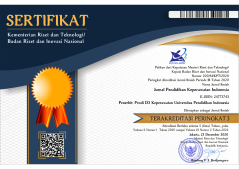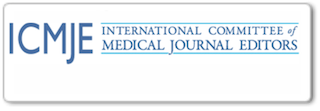Penggunaan Highly Active Antiretroviral Theraphy (HAART) Terhadap Health Related Quality of Life (HRQOL) pada Orang Dengan HIV/AIDS
Abstract
ABSTRAK
HIV/AIDS merupakan salah satu penyakit yang dapat menyebabkan kematian pada penderitanya. Penyakit ini mengganggu kualitas hidup penderitanya. Terlebih lagi sampai saat ini penyakit HIV/AIDS belum ada obatnya. Meskipun demikian, penyakit HIV/AIDS dapat dikendalikan dengan penggunaan terapi antiretroviral. Saat ini terapi antiretroviral sudah banyak dikembangkan dan golongan terbaru yang dianggap cukup efektif mengendalikan gelaja HIV/AIDS yaitu Highly Active Anti-Retroviral Therapy (HAART). Artikel ini bertujuan untuk mengidentifikasi penggunaan HAART terhdap health related quality of life (HRQOL) atau kualitas hidup kesehatan dari orang dengan HIV/AIDS (ODHA). Penelusuran literatur dilakukan melalui database PubMed dan ProQuest Nursing and Allied Health Source (Januari 2005 – Oktober 2017), menggunakan kata kunci penelusuran “quality of life”, “helath related quality of life”, “HAART”, dan HIV/AIDS. Selain itu, artikel yang dipilih dibatasi hanya pada penelitian original. Hasil kajian mengungkapkan bahwa penggunaan HAART pada ODHA dapat menekan jumlah virus HIV yang berdampak meningkatkan kadar CD4 dalam tubuh. Penggunaan HAART dapat meningkatkan sistem kekebalan tubuh ODHA, sehingga usia penderita HIV/AIDS cenderung memanjang dan kualitas hidup pun menjadi lebih baik. Namun di sisi lain, penggunaan HAART yang dikonsumsi ODHA seumur hidup juga memiliki efek samping terkait toksisitas obat tersebut. Ada kalanya beberapa ODHA mengalami komplikasi dari penggunaan obat HAART tersebut. Oleh karena itu penggunaan obat HAART sebaiknya dilakukan secara teratur dengan pengawasan tim medis atau perawat yang kompeten dalam pemberian terapi antiretroviral.
ABSTRACT
HIV/AIDS is one disease that cause death. This disease can reduce the quality of life of peple living with HIV/AIDS (PLWHA). There is no cure for HIV/AIDS, until now. However, HIV/AIDS is a deadly disease and incureable, but this disease can be controlled with the use of antiretroviral therapy. Currently, antiretroviral therapy has been widely developed and the latest class was considered quite effective in controlling the HIV/AIDS is Highly Active Anti-Retroviral Therapy (HAART). This article aims to identify the use of HAART on health related quality of life (HRQOL) or the quality of life of PLWHA. The methode used was the literature review. The literature search was conducted through the PubMed and ProQuest Nursing and Allied Health Source (January 2005 – October 2017) databases, were searched using keyword term "quality of life", "health related quality of life", "HAART" and “HIV/AIDS”. In addition, the selected article is limited only to original research. The study results revealed that the use of HAART in people living with HIV/AIDS could reduce the viral load, so that can increase the levels of CD4 in the body. HAART could improve the immune system of PLWHA, so the age of PLWHA tend to elongate and the quality of life can be better. However, the use of HAART also has side effects related to the toxicity of the drug. Some PLWHA experience complications from the use of HAART drugs. Therefore, the use of HAART drugs should be carried out regularly with the supervision of a medical team or nurse who is competent in the administration of antiretroviral drugs.
Keywords
Full Text:
PDFReferences
Anene Agu, K., Okojie, O., Oqua, D., King, R., Isah, M., Gerald Iyaji, P., . . . Wutoh, A. (2013). Health-Related Quality of Life and CD4 cells status of Patients receiving Antiretroviral Therapy in Nigeria. West African Journal of Pharmacy, 23(2).
Augustyn, C., Walker, B., & Goss, T. F. (2012). Recognizing the value of innovation in HIV/AIDS therapy. Boston: Boston Healthcare Associates, Inc.
Basavaraj, K. H., Navya, M. A., & Rashmi, R. (2010). Quality of life in HIV/AIDS. Indian J Sex Transm Dis, 31(2), 75-80. doi: 10.4103/0253-7184.74971
Bastardo, Y. M., & Kimberlin, C. L. (2000). Relationship between quality of life, social support and disease-related factors in HIV-infected persons in Venezuela. AIDS care, 12(5), 673-684.
Burgoyne, R. W., & Tan, D. H. (2008). Prolongation and quality of life for HIV-infected adults treated with highly active antiretroviral therapy (HAART): a balancing act. Journal of antimicrobial chemotherapy, 61(3), 469-473.
Deeks, S. G., Lewin, S. R., & Havlir, D. V. (2013). The end of AIDS: HIV infection as a chronic disease. The Lancet, 382(9903), 1525-1533.
Geschwind, M., Skolasky, R., Royal, W., & McArthur, J. (2001). The relative contributions of HAART and alpha-interferon for therapy of progressive multifocal leukoencephalopathy in AIDS. Journal of Neurovirology, 7(4), 353-357.
Guaraldi, G., Murri, R., Orlando, G., Giovanardi, C., Squillace, N., Vandelli, M., . . . Wu, A. W. (2008). Severity of Lipodystrophy Is Associated with Decreased Health-Related Quality of Life. AIDS Patient Care and STDs, 22(7), 577-585. doi: 10.1089/apc.2007.0173
Gunda, D. W., Kilonzo, S. B., Kamugisha, E., Rauya, E. Z., & Mpondo, B. C. (2017). Prevalence and risk factors of poor immune recovery among adult HIV patients attending care and treatment centre in northwestern Tanzania following the use of highly active antiretroviral therapy: a retrospective study. BMC Research Notes, 10(1), 197. doi: 10.1186/s13104-017-2521-0
Holzemer, W. L., & Wilson, H. S. (1995). Quality of life and the spectrum of HIV infection. Annu Rev Nurs Res, 13, 3-29.
Jelsma, J., Maclean, E., Hughes, J., Tinise, X., & Darder, M. (2005). An investigation into the health-related quality of life of individuals living with HIV who are receiving HAART. AIDS care, 17(5), 579-588.
Jia, H., Uphold, C. R., Wu, S., Chen, G. J., & Duncan, P. W. (2005). Predictors of changes in health-related quality of life among men with HIV infection in the HAART era. AIDS Patient Care & STDs, 19(6), 395-405.
Johnson, L. F., Mossong, J., Dorrington, R. E., Schomaker, M., Hoffmann, C. J., Keiser, O., . . . Giddy, J. (2013). Life expectancies of South African adults starting antiretroviral treatment: collaborative analysis of cohort studies. PLoS medicine, 10(4), e1001418.
Letamo, G. (2003). Prevalence of, and factors associated with, HIV/AIDS-related stigma and discriminatory attitudes in Botswana. Journal of Health, Population and Nutrition, 21(4), 347-357.
Liu, C., Ostrow, D., Detels, R., Hu, Z., Johnson, L., Kingsley, L., & Jacobson, L. P. (2006). Impacts of HIV infection and HAART use on quality of life. Quality of Life Research, 15(6), 941-949. doi: http://dx.doi.org/10.1007/s11136-005-5913-x
Liu, C., Weber, K., Robison, E., Hu, Z., Jacobson, L. P., & Gange, S. J. (2006). Assessing the effect of HAART on change in quality of life among HIV-infected women. AIDS research and therapy, 3(1), 6.
Lv, R., Li, G., Wu, J., Zhu, Y., Li, J., Qin, X., . . . Xu, C. (2017). Investigation of the survival time and quantification of therapeutic benefits for HIV patients with highly active antiretroviral therapy. Biomedical Research, 28(1).
Mannheimer, S., Matts, J., Telzak, E., Chesney, M., Child, C., Wu, A., . . . AIDS, T. B. C. P. f. C. R. o. (2005). Quality of life in HIV-infected individuals receiving antiretroviral therapy is related to adherence. AIDS care, 17(1), 10-22.
Nakagawa, F., May, M., & Phillips, A. (2013). Life expectancy living with HIV: recent estimates and future implications. Current opinion in infectious diseases, 26(1), 17-25.
Peltzer, K. (2012). Health-related quality of life and antiretroviral therapy in Kwazulu-Natal, South Africa. Social Behavior and Personality, 40(2), 267-282.
Protopopescu, C., Marcellin, F., Spire, B., Préau, M., Verdon, R., Peyramond, D., . . . Carrieri, M.-p. (2007). Health-related quality of life in HIV-1-infected patients on HAART: a five-years longitudinal analysis accounting for dropout in the APROCO-COPILOTE cohort (ANRS CO-8). Quality of Life Research, 16(4), 577-591. doi: http://dx.doi.org/10.1007/s11136-006-9151-7
Revicki, D., Osoba, D., Fairclough, D., Barofsky, I., Berzon, R., Leidy, N., & Rothman, M. (2000). Recommendations on health-related quality of life research to support labeling and promotional claims in the United States. Quality of Life Research, 9(8), 887-900. doi: 10.1023/A:1008996223999
Roberts, K. J. (2002). Physician-patient relationships, patient satisfaction, and antiretroviral medication Adherence among HIV-infected adults attending a public health clinic. AIDS Patient Care STDS, 16(1), 43-50. doi: 10.1089/108729102753429398
Shumaker, S. A., Ellis, S., & Naughton, M. (1997). Assessing health-related quality of life in HIV disease: key measurement issues. Quality of Life Research, 6(6), 475-480. doi: 10.1023/A:1018499813912
Siddiqui, U., Bini, E. J., Chandarana, K., Leong, J., Ramsetty, S., Schiliro, D., & Poles, M. (2007). Prevalence and impact of diarrhea on health-related quality of life in HIV-infected patients in the era of highly active antiretroviral therapy. Journal of clinical gastroenterology, 41(5), 484-490.
The Antiretroviral Therapy Cohort Collaboration. (2017). Survival of HIV-positive patients starting antiretroviral therapy between 1996 and 2013: a collaborative analysis of cohort studies. The Lancet HIV, 4(8), e349-e356. doi: https://doi.org/10.1016/S2352-3018(17)30066-8
Tramarin, A., Parise, N., Campostrini, S., Yin, D. D., Postma, M. J., Lyu, R., . . . Starace, F. (2004). Association between diarrhea and quality of life in HIV-infected patients receiving highly active antiretroviral therapy. Quality of Life Research, 13(1), 243-250. doi: http://dx.doi.org/10.1023/B:QURE.0000015282.24774.36
Van Sighem, A. I., Van de Wiel, M. A., Ghani, A. C., Jambroes, M., Reiss, P., Gyssens, I. C., . . . Group, A. C. S. (2003). Mortality and progression to AIDS after starting highly active antiretroviral therapy. AIDS, 17(15), 2227-2236.
WHO. (1997). WHOQOL: Measuring quality of life. Geneva: WHOQOL Group - World Health Organization.
Wilson, I. B., & Cleary, P. D. (1995). Linking clinical variables with health-related quality of life. A conceptual model of patient outcomes. JAMA, 273(1), 59-65.
Wu, A. (2000). Quality of life assessment comes of age in the era of highly active antiretroviral therapy. AIDS, 14(10), 1451.
DOI: https://doi.org/10.17509/jpki.v4i2.14093
Refbacks
- There are currently no refbacks.
Jurnal Pendidikan Keperawatan Indonesia(JPKI) published by Indonesia University of Education. JPKI is licensed under a Creative Commons Attribution-ShareAlike 4.0 International License.
Office :
Nursing Department. FPOK UPI.
229, Dr. Setiabudhi Street. Bandung 40154
West Java , Indonesia
E-mail : jpki@upi.edu

_.png)
_.png)
_.png)











